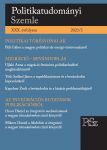Mozgó törésvonalak a magyar politikai térben. Hogyan lett a két ellenzékből egy a választói térelmélet szerint?
Shifting faultlines in the Hugarian political space. How the two oppositions have become one according to the spatial theory of voting?
Author(s): Gábor PéliSubject(s): Political behavior, Political psychology
Published by: MTA Politikai Tudományi Intézete
Keywords: Organizational ecology; organizational niche; oppositional identity; party competition; political space; proximity theory
Summary/Abstract: A puzzling aspect of Hungarian politics is the centerwise migration urge of the oppositional party Jobbik, dominating the right side of the political spectrum for long. Until the end of 2020, however, no remarkable change has taken place, in terms of political coordinate changes, between the stances of the left-liberal and rightist (Jobbik) oppositional blocks, meanwhile the government-opposition relationship has been substantially transformed. I apply the political space approach of Downs for studying this elongated getting-not-getting-closer period during the 2010s. I demonstrate that it was the relative political distance between the oppositional blocks, i. e., their distance compared to their remoteness to government positions, that has diminished, in parallel with a new political space dimension’s becoming dominant. The relative distance change did not require modifying the, oftentimes diametrical, political views of the oppositional blocks. By the end of the decade, their relative closing has been complemented with absolute distance decrease, as well as with aligning political space positions.
Journal: Politikatudományi Szemle
- Issue Year: XXX/2021
- Issue No: 3
- Page Range: 7-24
- Page Count: 18
- Language: Hungarian

